- Thread starter 186thFCo
- Start date
You are using an out of date browser. It may not display this or other websites correctly.
You should upgrade or use an alternative browser.
You should upgrade or use an alternative browser.
It depends on your specific components and chamber.
Work up until you find pressure, then find a node south of the pressure. Book max tends to be very conservative. I wouldn't recommend loading max pressure loads until you know what you are doing, which by asking this question it sounds like you are a new loader. I usually find max pressure no more than 2-3gr over book max (there are exceptions) for most loads that I've worked up. YMMV and load over book max at your own risk.
Last edited:
I don’t have some amount I’m willing to go over published max and some amount I won’t. With most calibers, especially .308/ 6.5CM and similar capacity calibers, I’ve found case fill/ compression is the best way to guess at pressure problems before actually firing. If you’re at less than 100% case fill, you’re probably still fine in most situations. In the past 7 years, I don’t think I’ve ever had an extreme pressure sign on a piece of brass, and I have regularly loaded WAY above published max loads. Anyone with mild competence and intelligence doesn’t need to chain themselves to never going past published data, especially considering most manuals use stupidly high bullet jump and virgin brass, significantly decreasing case capacity. If you use common sense, stay away from highly compressed loads, and build up incrementally above the published loads looking for pressure on the way, you have nothing to fear.
I listen to the guy with no hands.
Another consideration- Pressure spike is going to be relative to bullet jump. I've had pressure signs (cratered primers, swipe marks on brass) with loads just at max when I had bullet seated at the lands. When backed off to .050 no problem and I can go higher.
I am not telling you to load over book max, but like it has been stated, most manuals are more than conservative. It gets worse by the year also, if you had access to older manuals, and had the time, you could find how charges over the yrs have dropped for the same bullet used.
Berger has more or less stated, all the data in their manual is Quickload based, no shooting whatsoever.
The software Quickload is worth the investment, not tough to use either.
There is nothing wrong with trying to find pressure with the components you are going to use, just go up in charge in smaller increments till you feel primer rupture, stiffer bolt lift, or casehead marks.
If I want to find max pressure, I go up .2gr in cases that have 35gr capacity, .3gr in cases that hold 50gr, in larger, I go up in .5gr increments. It surely is not needed to know what you are going to shoot will actually handle, but it can give you piece of mind knowing that you are not close if problems arise later down the road.
Berger has more or less stated, all the data in their manual is Quickload based, no shooting whatsoever.
The software Quickload is worth the investment, not tough to use either.
There is nothing wrong with trying to find pressure with the components you are going to use, just go up in charge in smaller increments till you feel primer rupture, stiffer bolt lift, or casehead marks.
If I want to find max pressure, I go up .2gr in cases that have 35gr capacity, .3gr in cases that hold 50gr, in larger, I go up in .5gr increments. It surely is not needed to know what you are going to shoot will actually handle, but it can give you piece of mind knowing that you are not close if problems arise later down the road.
There are many variables you've left out of the equation with your question that will have a direct impact.
Even if you are using the exact same components as those laid out in the manual that doesn't necessarily mean you won't encounter pressure at or below max listed charges.
The main reason I say that is differences in internal case volume even from the same manufacturer from a differnt lot of brass, differences in burn rate from the same powder but different lot.
And then there are many others that can have an impact.
Slightly different chamber specs and freebore than what was used for the test barrel.
A different land to groove ratio or slightly tighter bore specification than the test barrel.
Some can be false pressure signs from an overly generous firing pin to bolt face fit or being overgassed in the case of an AR since you didn't specify which one.
As others have stated treat each rifle as an individual and carefully work up your charge weight while closely observing for pressure signs.
The books can be conservative in many cases but that's no reason for complacency.
For the most part I've usually found that when approaching the max listed charge is were the accuracy nodes are but that is also with different components ( Brass, Primer) than what were listed.
Even if you are using the exact same components as those laid out in the manual that doesn't necessarily mean you won't encounter pressure at or below max listed charges.
The main reason I say that is differences in internal case volume even from the same manufacturer from a differnt lot of brass, differences in burn rate from the same powder but different lot.
And then there are many others that can have an impact.
Slightly different chamber specs and freebore than what was used for the test barrel.
A different land to groove ratio or slightly tighter bore specification than the test barrel.
Some can be false pressure signs from an overly generous firing pin to bolt face fit or being overgassed in the case of an AR since you didn't specify which one.
As others have stated treat each rifle as an individual and carefully work up your charge weight while closely observing for pressure signs.
The books can be conservative in many cases but that's no reason for complacency.
For the most part I've usually found that when approaching the max listed charge is were the accuracy nodes are but that is also with different components ( Brass, Primer) than what were listed.
Depends what book they hardly ever agree on anything anyways. For example in several 223's I usually shoot the 55 grain bullet with benchmark 25.5 grains which is .5 over max according to Nosler but .1 under max according to Hornady. Watch for the signs and have a good feeling for your gun. I would get a lil nervous going two grains over a published max,
Sorry, but those 2 manuals you listed will never have the exact same bullet listed. I am not sure how or what you are comparing.Depends what book they hardly ever agree on anything anyways. For example in several 223's I usually shoot the 55 grain bullet with benchmark 25.5 grains which is .5 over max according to Nosler but .1 under max according to Hornady. Watch for the signs and have a good feeling for your gun. I would get a lil nervous going two grains over a published max,
@Milo 2.5 I’ve seen Hodgdon’s published data and Hornady’s published data for the same bullet be off considerably before. I know you’re making the point that he is looking at 2 different manufacturer’s bullets in the same weight class, and that’s not a good comparison, but I’m just saying it isn’t impossible to find 2 different published data sets for the same bullet, and they often have fairly large gaps between them.
Hornady data is based on Hornady brass which often has less capacity than Winchester brass used by Hodgdon. Hence the difference in powder charge.
Right, I just addressed what he posted, and I was saying bullet companies manuals differ from powder companies data. No 2 bullets are the same. We can get general ideas if both are held in your hand, but it ends there.@Milo 2.5 I’ve seen Hodgdon’s published data and Hornady’s published data for the same bullet be off considerably before. I know you’re making the point that he is looking at 2 different manufacturer’s bullets in the same weight class, and that’s not a good comparison, but I’m just saying it isn’t impossible to find 2 different published data sets for the same bullet, and they often have fairly large gaps between them.
Another good point. It is up to each of us to determine what is safe, it'd be nice if we could learn this overnight, not the way it works though, at least in my case.Hornady data is based on Hornady brass which often has less capacity than Winchester brass used by Hodgdon. Hence the difference in powder charge.
I think part of the problem is people want to max out their load and seat close to the lands because they think that will give them accuracy.
I have found that if you have a standard factory chamber and use Hodgdon’s data using the same components and stay away from the lands (.030” or more) then you can exceed their powder charge by .5 grains in teeny cases, 1 grain in small cases, and 2 grains in big cases before you get sticky bolt. Assuming you have appropriately hard brass, sticky bolt happens around 70,000 PSI.
I have found that if you have a standard factory chamber and use Hodgdon’s data using the same components and stay away from the lands (.030” or more) then you can exceed their powder charge by .5 grains in teeny cases, 1 grain in small cases, and 2 grains in big cases before you get sticky bolt. Assuming you have appropriately hard brass, sticky bolt happens around 70,000 PSI.
I am not telling you to load over book max, but like it has been stated, most manuals are more than conservative. It gets worse by the year also, if you had access to older manuals, and had the time, you could find how charges over the yrs have dropped for the same bullet used.
Berger has more or less stated, all the data in their manual is Quickload based, no shooting whatsoever.
The software Quickload is worth the investment, not tough to use either.
There is nothing wrong with trying to find pressure with the components you are going to use, just go up in charge in smaller increments till you feel primer rupture, stiffer bolt lift, or casehead marks.
If I want to find max pressure, I go up .2gr in cases that have 35gr capacity, .3gr in cases that hold 50gr, in larger, I go up in .5gr increments. It surely is not needed to know what you are going to shoot will actually handle, but it can give you piece of mind knowing that you are not close if problems arise later down the road.
I just ordered Quickload on Berger’s recommendation. That said, I usually end up over book or QL recommendations on production rifles. My Rem 700 was always low in velocity compared to the book and seemed to give clears signs when there was pressure problems. I would look at primers, ejector marks, velocity etc as I went up. I also factor in temperature stability and test at different temperatures.
On my Mauser I am being more cautious because the max pressure is 51,000 cup I was told. Its almost 100 years old and there is no gas relief hole.
I have one rifle that I can load over the average book recommended max. A custom action 6.5-284. I approached this load with caution. Extreme caution. I'm getting no primer signs, no ejector marks, normal to long case life. Its just unnerving to be a test pilot! My experience is that I get pressure signs at about the point that the load tables max out.
If you are a new reloader stick with the book. That said, the book is but a guide line. Once you have been at it awhile you will understand many things never printed in books or talked about openly. I have two 308 loads the will get a 190smk to a grand with 32.5 moa of up an group under 1/2moa. You will never see a sign of pressure on the case or primer, but when you open the bolt the primer will fall out of the case an it will never except another primer again. Pressure pikes will mark the case or primer,... but,... you can hold just under max pressure much longer than normal with some powders an obtain faster speeds.
I’m not brand new to reloading, but now I am getting into the more advanced stuff if that makes sense. I took my R700 out and loaded up some 168gr Berger VLD’s to see if I could find a velocity node and to see where the pressure signs start. Using virgin Hornady brass, H1000, CCI 250 mag primers, and 168gr VLD’s I loaded .5gr increments from 62gr of powder to 73.5gr 22 rounds total. Book max is 72gr. I found a nice node at the top end of what I loaded up with 72.5gr (3122 fps) and 73gr (3127 FPS) with no pressure signs, the next and finale round was loaded with 73.5gr and ended up with a sticky bolt.
I’m going to load up some more between 72.5gr and 73gr and see if I can’t confirm what I found and than go from there.
I’m going to load up some more between 72.5gr and 73gr and see if I can’t confirm what I found and than go from there.
On my Mauser I am being more cautious because the max pressure is 51,000 cup I was told. Its almost 100 years old and there is no gas relief hole.
^ This is an appropriate observation. Some actions/receivers are better equipped to handle pressure. A modern Remington 700 can handle a pretty severely overpressure .223 Remington, but an overpressure .338 Lapua-sized case head in the same action is flirting with disaster from "bolt thrust" beyond the receiver's design and materials capabilities.
Some guns are stronger than others. If you're going to exceed max book pressures, or play the wildcat game, then it's wise to start with a strong action from the beginning.
You will see big differences with different manufactures of brass. But wou will also see differences in lot #'s. This goes for bullets, powder, primers and brass. Not to mention barrel length and bore diameter (including any loose spots in the barrel). Then you have chamber (headspace and throat). So many things change pressure, you just need to work up slowly looking for signs of pressure. Popular cartridges will have lots of data on common combos that you can get a good feel for what the books say and what people are doing (like with Lapua Brass, H4350, Berger 140gr Hybrids for 6.5 Creedmoor). Also remember that environmentals effect pressure. Temperature changes burn rates, and water in your chamber, or on your ammo, will increase pressure
You could always practice on cedar tree brush piles with gasoline.
See how much gas it takes before you get burned.
No real need to go overboard!
Imho: there is usually a node just under published max for about everything,
or maybe I'm just lucky.
See how much gas it takes before you get burned.
No real need to go overboard!
Imho: there is usually a node just under published max for about everything,
or maybe I'm just lucky.
Learn and respect the early signs of pressure step one. There are a lot of reasons why you can go above book max or not make it to book max from rifle to rifle.
Another reason not to run too high of pressure intentionally is the chance of a miss measure of powder and catching a hot charge. With no room for error you run I higher risk of catastrophic failure.
Another reason not to run too high of pressure intentionally is the chance of a miss measure of powder and catching a hot charge. With no room for error you run I higher risk of catastrophic failure.
I was running right on max load in the Nosler manual and recently found out it's 1.4gr more than the Berger manual. My loads ran fine at that... until this past weekend shooting a match in the rain. One stage my rounds or chamber must've gotten wet and I experienced a pretty heavy bolt lift and some good ejector mark on the case head. So the book may be conservative, but it's also for ideal conditions.
Time to back the loads off half a grain or so and test it out again.
Time to back the loads off half a grain or so and test it out again.
What brass does the Berger manual use vs what the Nosler manual uses?
What brass does the Berger manual use vs what the Nosler manual uses?
Not entirely sure. I'm using Lapua SRP brass (6.5 Creedmoor) and I don't even think it was around when the Nosler manual was published. It just goes to show that everyone should start loading below max. book load and work up.
I have loads over max but I am getting more conservative as I go. I find that changing components like primers or messing with seating depth usually dials in the last bit of accuracy. I got in a serious overpressure situation with some preliminary book data from a major bullet manufacturer. End result was throwing a lot of brass away and shooting more accurately with far less powder. If max loads won’t give the velocity you want go up to a larger caliber. It’s not worth it
What bullet was in both of those manuals? I'm rolling with not a one, 2 bullet companies.I was running right on max load in the Nosler manual and recently found out it's 1.4gr more than the Berger manual. My loads ran fine at that... until this past weekend shooting a match in the rain. One stage my rounds or chamber must've gotten wet and I experienced a pretty heavy bolt lift and some good ejector mark on the case head. So the book may be conservative, but it's also for ideal conditions.
Time to back the loads off half a grain or so and test it out again.
On your wet chamber, bolt guns are not made to be shot with wet ammo, and yes, it may have been hot. It has to do with room in the chamber, water is not displaced when a rd is fired. Maybe using a small base die instead may account for the room needed.
What bullet was in both of those manuals? I'm rolling with not a one, 2 bullet companies.
On your wet chamber, bolt guns are not made to be shot with wet ammo, and yes, it may have been hot. It has to do with room in the chamber, water is not displaced when a rd is fired. Maybe using a small base die instead may account for the room needed.
Nosler Manual was using the Accubond LR and Berger was using the 130gr Target bullet I believe. Neither were the exact bullet I'm using.
What I was trying to say is no 2 bullets are alike, just because it is a 130gr, does not make them equal. You may have a slight variance in diameter, bearing surface, etc...Nosler Manual was using the Accubond LR and Berger was using the 130gr Target bullet I believe. Neither were the exact bullet I'm using.
It is best to just get a feel for the bullet you plan to shoot by working into the charge.
Like I said, bullet companies have load data, and powder companies have load data.
Now this is just my opinion, but Sierra has always had the most realistic data for their bullets compared to others.
What I was trying to say is no 2 bullets are alike, just because it is a 130gr, does not make them equal. You may have a slight variance in diameter, bearing surface, etc...
It is best to just get a feel for the bullet you plan to shoot by working into the charge.
Like I said, bullet companies have load data, and powder companies have load data.
Now this is just my opinion, but Sierra has always had the most realistic data for their bullets compared to others.
Oh for sure. I had worked up my load without any issues whatsoever, just when it got wet is when I experienced some pressure.
On your wet chamber, bolt guns are not made to be shot with wet ammo, and yes, it may have been hot. It has to do with room in the chamber, water is not displaced when a rd is fired. Maybe using a small base die instead may account for the room needed.
I have this dilemma when doing cold ammo testing on a warm day even in the semi arid climate here in Wyoming, at 7200 feet. I put the ammo in a ziplock submerged in ice overnight to get 32 degs. It comes out of the baggie dry but starts getting a condensation film immediately as I load it into the chamber. I do this one by one as fast as I can to mitigate. I have not noticed pressure problems but I wonder if the velocity is higher due to higher pressure.....
If you live in WY, shoot the stuff after leaving it sit in your vehicle overnight shoot the gun and ammo cold the next morning, truer test.I have this dilemma when doing cold ammo testing on a warm day even in the semi arid climate here in Wyoming, at 7200 feet. I put the ammo in a ziplock submerged in ice overnight to get 32 degs. It comes out of the baggie dry but starts getting a condensation film immediately as I load it into the chamber. I do this one by one as fast as I can to mitigate. I have not noticed pressure problems but I wonder if the velocity is higher due to higher pressure.....
Nothing really good comes from wet ammo, in my world anyway, whether condensation, water, lube or oils, lol
Understood but I am a hunter. Stuff getting wet is unavoidable. Waiting for cold weather to run test is not really ideal. Further, the ambient temp is changing so know exactly what your powder is by using ambient temp is hard. An ice soak gives me a constant 32 +or minus a couple degrees which is why I do it. I guess nothing is ideal......If you live in WY, shoot the stuff after leaving it sit in your vehicle overnight shoot the gun and ammo cold the next morning, truer test.
Nothing really good comes from wet ammo, in my world anyway, whether condensation, water, lube or oils, lol
Attachments
-
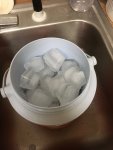 B6AE8A20-A60B-446D-B594-7BB1B74D920A.jpeg363.8 KB · Views: 40
B6AE8A20-A60B-446D-B594-7BB1B74D920A.jpeg363.8 KB · Views: 40 -
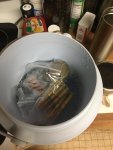 68B24949-7795-421D-AEFB-21EBCA145F7A.jpeg360.5 KB · Views: 50
68B24949-7795-421D-AEFB-21EBCA145F7A.jpeg360.5 KB · Views: 50 -
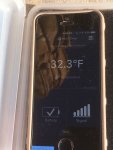 CA39AD8E-2132-413D-A934-66595D5A631E.jpeg376.5 KB · Views: 49
CA39AD8E-2132-413D-A934-66595D5A631E.jpeg376.5 KB · Views: 49 -
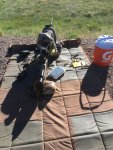 05CFB4C6-06ED-4EF7-BBB1-01C6E0BB2E03.jpeg841.2 KB · Views: 56
05CFB4C6-06ED-4EF7-BBB1-01C6E0BB2E03.jpeg841.2 KB · Views: 56 -
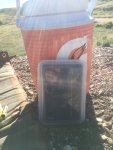 2B0EDA49-BCCC-45EC-B5E8-823774443651.jpeg416.1 KB · Views: 42
2B0EDA49-BCCC-45EC-B5E8-823774443651.jpeg416.1 KB · Views: 42
Lol, no shit.Understood but I am a hunter. Stuff getting wet is unavoidable. Waiting for cold weather to run test is not really ideal. Further, the ambient temp is changing so know exactly what your powder is by using ambient temp is hard. An ice soak gives me a constant 32 +or minus a couple degrees which is why I do it. I guess nothing is ideal......
I just remember a time, I left my AR and ammo in my PU, headed to the range the next day. 15 deg, I got an eye opening quickly, Win 748, not even remotely a stable powder, it was 3 moa low at 300 yards. Guys run all kinds of tests with hot ammo, ammo from coolers etc, but ammo warms or cools quick once in ambient air, so I have always questioned most cool or cold side tests.
But yes, you are right, your ammo needs to be safe in the conditions you encounter. But here in WY, it is easy to shoot the gauntlet of temps, if you have the time<which is big I know. I'm retired, have more time than most, I went out and shot a few in the snow this am, I can guarantee, my ammo did not get wet, lol
But here in WY,
Sweet, did not realize you are a fellow Wyoming resident.
Does it really matter (pressure wise) that much for the same type bullet from different manufacturers?
But then load data from different places can be a few grains different.
I've wasted a lot of time and material starting well below max and ending up well past max with no pressure signs.
To the pointing in the future I'm going to start 1 below published max.
But then load data from different places can be a few grains different.
I've wasted a lot of time and material starting well below max and ending up well past max with no pressure signs.
To the pointing in the future I'm going to start 1 below published max.
If this is for me, I referenced a comment made on 2 books, 2 diff bullets, 2 diff charges. Answering your question, common sense says no, all bullets are diff though. Esp 22 cal bullets,, ballistic tips-vmax's, blitzkings comparison.Does it really matter (pressure wise) that much for the same type bullet from different manufacturers?
But then load data from different places can be a few grains different.
I've wasted a lot of time and material starting well below max and ending up well past max with no pressure signs.
To the pointing in the future I'm going to start 1 below published max.
Same goes for transferring a load from one barrel to the next, they do not always line up.
I have a friend, his sig line goes like this, "start at max and work up". lmao
Not directed at anyone in particular. Just went through this last weekend testing through a span of 2 grains and like 50 rds. left feeling like damn I could have thrown out the lower half and went a grain or more higher.
I'm right there with your friend start at or just below max and work up.
I'm right there with your friend start at or just below max and work up.
So many variables that published data usually just a rough guide.
I the same barrel with the same headspace, powder, primer and bullet one brand of brass would blow primers 1 grain before book max and another brand of brass coasts along comfortably with long life running over 2 grains above book max.
I the same barrel with the same headspace, powder, primer and bullet one brand of brass would blow primers 1 grain before book max and another brand of brass coasts along comfortably with long life running over 2 grains above book max.
Similar threads
- Replies
- 2
- Views
- 269
